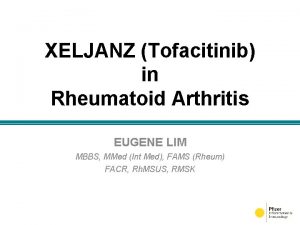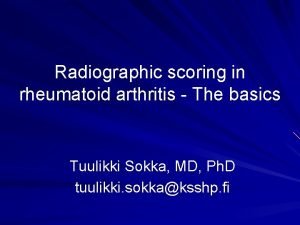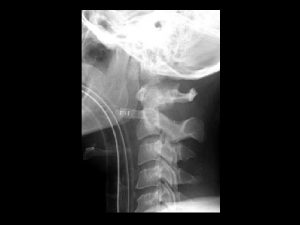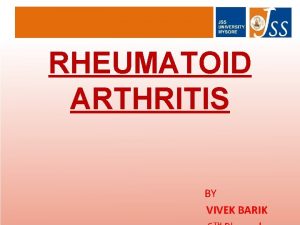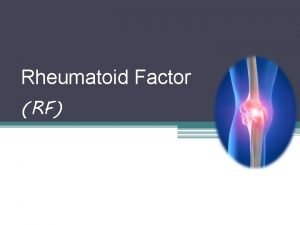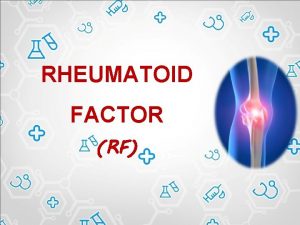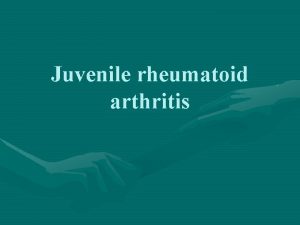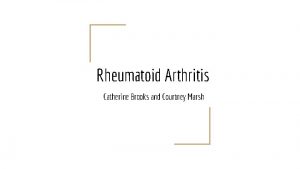RHEUMATOID FACTOR RFLATEX TEST Rheumatoid factors RF first











- Slides: 11

RHEUMATOID FACTOR (RF)-LATEX TEST: Rheumatoid factors (RF), first described in 1940 as antibodies reacting with gamma globulins, rheumatoid factors are autoantibodies Ig. M and sometime Ig. G (macroglobulin having a molecular weight of about one million dalton) bind to the fc portion of other igg molecules (autoantigen), and form Ig. G -anti- Ig. G complexes in the circulation or joint fluid. The disease commonly associated with high RF concentrations presence in the blood and in synovial fluid is rheumatoid arthritis, and normal levels < 8 I. U/ml.

Normally, antibodies are produced by the immune system to help destroy and eliminate invading bacteria and viruses that can cause disease. But autoantibodies usually attack the patient's own tissues (autoantigen), mistakenly identifying them as foreign, resulting in damage.

Rheumatoid Arthritis (RA) is a chronic systemic disease generally characterized by warmth, swelling, and morning stiffness in the joints, nodules under the skin, fatigue and loss of appetite and by inflammatory, degenerative processes involving cartilage, synovial membrane or muscle tissue. No specific cure has been found; early therapy helps in halting or minimizing irreversible damage to the joints. For this reason, prompt diagnosis is of importance.

The test for RF may be ordered when a patient has signs of RA. About 80% of people with rheumatoid arthritis have detectable rheumatoid factor in their blood. A rheumatoid factor (RF) blood test detects and measures the amount of the RF antibody present in the blood. The RF test is sensitive but nonspecific. It is most closely associated with rheumatoid arthritis (RA) but may also be present in a variety of other autoimmune disorders, such as Sjögren's syndrome.

It should be noted that incidence of RF (Increase of RF) have been reported in a variety of non-rheumatic diseases such as pulmonary tuberculosis, bacterial endocarditis, syphilis, as well as others. A significant incidence of RF in the aged has also been observed. Diagnosis of rheumatoid arthritis Medical history and physical examination, looking for distribution of joints affected, joint swelling, warmth, as well as the presence of nodules under the skin. Imaging studies such as X- rays, may be used to detect the degree of joint damage. A blood test can indicate the presence of an RF, which is found in 80% of people with RA.

Methods Latex used to detect RF agglutination method. Mixes the blood being tested with latex that is covered with human antibodies. If rheumatoid factor is present, agglutination occurs. Haemagglutination Mixes test. the blood being tested with a sheep's red blood cells that have been covered with rabbit antibodies. If RF is present, the red blood cells agglutinate.

Rapid latex agglutination Principle: The test is based on the reaction between patient antibodies in the serum, known as the rheumatoid factor; and an antigen derived from gamma globulin (heat treated human Ig. G). When serum containing rheumatoid factors is mixed with the latex reagent, visible agglutination occurs.

Procedure: Qualitative method: Allow each component to reach room temperature. Gently shake the latex reagent to disperse the particles. Add one drop of serum onto the black circle test slide, using the disposable pipettes provided. Add one drop of RF-latex reagent next to the drop of serum. Mix both drops with a stirrer and spread over the entire area of the test circle. Gently tilt or rotate the slide backwards and forwards for 2 minutes. Interpret results immediately after 2 minutes. Positive and negative controls should be included at regular intervals. Observe for agglutination.

Interpretation Positive of the results: reactions: when there is agglutination. Presence of agglutination indicates a level of RF in the serum sample equal or greater than 8 I. U/ml. Negative Absence reactions: No visible clumping, uniform suspension. of agglutination indicates a level of RF in the serum sample less than 8 I. U/ml.

Semi quantitative method: The semi quantitative test can be performed in the same way as the qualitative test using dilutions of the serum in saline, phosphate buffered saline or glycine saline as follows. 50 µl Serum 8 I. U/ml 50 µl 50 µl N. S 1: 2 1: 4 1: 8 1: 16 1: 32 8 x 4 8 x 8 8 x 16 8 x 32

Results: The titer is expressed as the reciprocal of the highest dilution showing macroscopic agglutination, e. g. if this occurs in dilution 3, the titer is 64. Factors interfere with positive result Hyperlipedemia. Age. Blood that is very high in fats. About 5% to 10% of people over age 65 have an elevated RF level.
